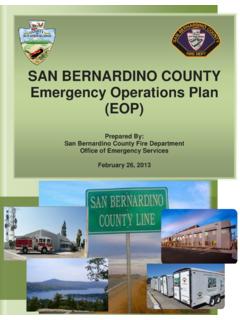Transcription of Continuity Planning for Computer Operations
1 Loss Control DepartmentTechnical Information Paper SeriesContinuity Planning forComputer Operations :An OverviewCopyright 1998 The Hartford Loss Control DepartmentTIPS Series S Printed in document is provided for information purposes only. It is not intended to be a substitute for individual legalcounsel or advice on issues discussed within. Readers seeking resolution of specific legal issues or businessconcerns related to the captioned topic should consult their attorney and/or insurance Planning for Computer Operations 1998 The Hartford Loss Control Department TIPS S Page 1 Continuity Planning forComputer Operations : An OverviewUnderstanding the Need for Emergency preparedness PlanningIn a recent survey, half the risk managers surveyed reported that their organizations hadexperienced natural or human disasters.
2 Were their facilities prepared for these events? Perhapsnot. Despite the need, many risk managers fail to prepare adequately for emergencies. Considerthese statistics: Fewer than 25% of American businesses have contingency plans. In the United States, 68% of business-affecting disasters are caused by human error; 25% bytechnology (hardware and software) failures; 5% by natural disasters; and 2% by terms of business survival, the results can be Of companies that experience a disaster but have no business recovery plan in place, 43%never reopen.
3 Of 350 businesses operating in New York s World Trade Center before the 1993 bombingthere, 150 that s 43% were closed a year later. 70% of businesses that closed for a month or more failed to reopen, or failed altogether withinthree years. Most companies that must operate ten or more days without their computers will never the costs enormous: Within eight days of an extended Computer outage, a company loses an estimated 2 to 3 % ofits gross sales. 55% of organizations have experienced a disruption or inability to access Computer systemsfor more than an hour, and 11% of large Computer users report disruptions of a day or more.
4 Three-quarters of businesses reach critical or total loss of functionality within two weeks oflosing Computer Plan for Emergencies?Disaster can strike at any time. Although most people think of disasters as naturally occurringevents such as hurricanes or earthquakes, other events or conditions can have disastrous in how business is conducted can exacerbate emergency situations. The growingdependence on technology and the increasingly complex hazards of various manufacturingoperations and processes increase the frequency, immediacy, and severity of disasters bothnatural and technological and contribute to the difficulty of recovery .
5 In today s businessclimate, it is more important than ever to have a well-considered, comprehensive EmergencyPreparedness Plan in place and ready to be Planning for Computer Operations 1998 The Hartford Loss Control Department TIPS S Page 2 How Can an Emergency preparedness Plan Make a Difference?Having an Emergency preparedness Plan allows you to make decisions about how to proceedwith emergency response and recovery before an emergency situation develops, when you arebest able to make difficult decisions.
6 Pre- Planning allows for better prevention, better response,and better recovery . Should a disaster strike, the actions taken in the first minutes and hours canmake all the difference to how soon or if normal Operations can be a plan, people will spend the initial precious minutes of an emergency situationfrantically trying to decide what to do, who should do it, and what to tackle first. With acomprehensive plan in place, an organized, prioritized, practiced response can beginimmediately, thus mitigating damage and perhaps even preventing loss of a recent survey, four of five risk managers reported that their plans had been effective duringemergency situations.
7 Another study showed that companies with disaster recovery plansexperience an average disruption of four to six hours, whereas companies without such plansexperience average disruptions of ten developing and implementing an effective Emergency preparedness Plan can be costlyand time-consuming, these costs are insignificant when compared to the potential losses acompany must bear in the event of a major Is an Emergency preparedness Plan?An Emergency preparedness Plan (or EPP) is the development, documentation, testing,evaluation, and implementation of policies, procedures, organizational structure, information,and resources that an entity can use to assess potential hazards, develop and prepare anappropriate response to each hazard, and develop and prepare strategies for Emergency preparedness objectives may differ from one organization to another, they arealmost always directed toward protection of people, protection of property.
8 And preparation forthe organization to resume productive Operations as soon as Emergency preparedness Plan generally encompasses three areas: Emergency preparedness is the process of developing and defining roles andresponsibilities, procedures, and resources for the Plan. Emergency Response is the process of implementing the organization s policies, procedures,and actions to stabilize and control an emergency as it occurs and throughout its duration. Emergency recovery is the process of implementing the organization s policies, procedures,and actions to resume the organization s normal Planning for Computer Operations 1998 The Hartford Loss Control Department TIPS S Page 3 Why Computer Operations Should Be Covered by Your Organization s EmergencyPreparedness PlanFor most companies, the information created, processed, and stored using Computer systems is avital corporate asset that must be safeguarded.
9 This recognition, along with legislation implyingexecutive accountability for business Continuity , has led to an increase in the need for disasterrecovery Planning for automation hardware, software, and data. The increased functionality ofautomation equipment, increasingly widespread Computer literacy, and innovative uses such aselectronic commerce on the Internet, have made automation integral to success in deliveringproducts and , protection of this valuable asset is often overlooked or only nominally consideredwhen automation projects are initiated.
10 This lack of foresight can make it difficult to backtrackto justify the costs of developing and maintaining disaster recovery plans at a later date. Bydeveloping a business contingency strategy, you will provide the framework for disaster recoveryplans that integrate your business and Continuity and ResponsibilitiesManagement must be involved at all levels to provide commitment, input, decisions, andapproval. Technical support personnel are needed to provide information on hardware, software,and data requirements; to help plan the recovery process; and to assist with testing.















